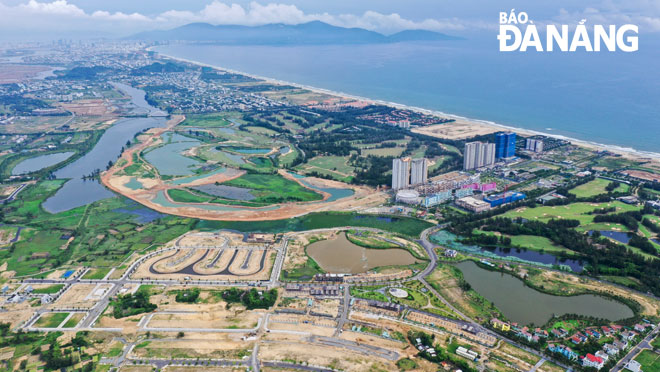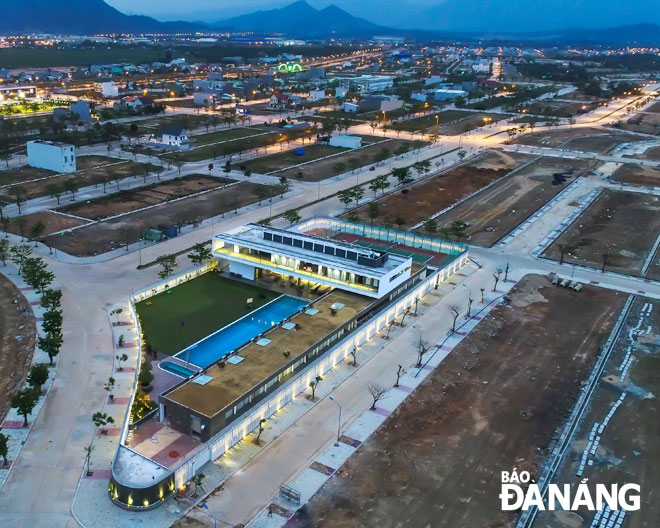Ideas suggested for realising adjustments to Da Nang master plan
Viet Nam's national government has signed a decision giving the green light to implement the adjustments to the master plan for Da Nang’s major developments by 2030, with a vision to 2045, a much-awaited sign leveraging the city’s comprehensive development in the new stage. The DA NANG Newspaper recorded many expectations from experts and enterprises about the realisation of this master plan adjustment project.
 |
| The southern part of Ngu Hanh Son District will belong to a so-called ‘economic belt’ showing off innovations and high-tech agriculture in southern part of Da Nang |
Investment attraction from domestic and foreign private enterprises to be the driver for long-term development
According to Mr Nguyen Tien Quang, Director of the Da Nang Branch of the Viet Nam Chamber of Commerce and Industry (VCCI), in addition to using financial resources from the national government to realise the master plan adjustment project, it is a need to promote administrative procedure reform, improve business environment with higher quality and standards, build up an attractive mechanism to attract more investment inflows from domestic and foreign private businesses. These should be considered priorities in the time ahead.
The funding from the national government should be considered to be‘bait capital’, whilst capital inflows from the domestic and foreign private sector should be regarded as the driver and a long-term development resource for Da Nang. How to increase the annual ratio of private investment to funding from the national government must be taken into account.
Adjustments to the master plan open up long-term development directions
In his perspectives, Mr Cao Tri Dung, Chairman of the Da Nang Tourism Association affirmed the fact that the national government’s approval on the master plan adjustment is the highest legal framework to guide Da Nang’s socio-economic development planning. The move offers the chance for Da Nang to map out long-term development directions with its own characteristics promoted, with a focus on making further development policies, redistributing the population, managing natural resource, and boosting investment attraction.
Under the adjustments, Da Nang tourism cluster will focus on embellishing the east coast and the edge of the Da Nang Bay, and developing cultural heritages, waterway tourism services, and ecotourism in the western and northern mountainous areas and on the Son Tra peninsula in a bid to fully tap their natural landscape and biodiversity potential.
This tourism expert also proposed developing more tourism clusters around the core areas such as the west associating with Ba Na-Nui Chua, the east with Son Tra Peninsula, the north with the Hai Van Pass and the south with the Marble Mountains Tourist Area.
 |
| A view of the Golden Hills urban area project |
Ensuring adequate water supplies in Da Nang
According to lecturer Le Hung from the Da Nang University of Technology and Science said, under the adjustments, the total daily demand for water across the city is expected to reach 800,000m3. Water sources currently are from Yen, Cau Do, Qua Giang, Cu De rivers, and Da, Tinh and Luong streams, Hoa Trung Lake and Bac River’s reservoir.
In order to ensure sufficient water supplies by 2030, it is a must-do to install another D.1200 pipeline with a large diameter to increase the daily capacity of transmission of water sources from the An Trach Anti-Salinity Pumping Station to the Cau Do Water Plant to 420,000 m3, and to build a pumping station and a water treatment plant in the Ha Thanh - Bau Nit dam system upstream of the Qua Giang River with a daily capacity of 120,000m3. It is also necessary to build a reservoir to ensure water exploitation with a daily capacity of 120,000 m3 in the Cu De river basin.
In the immediate future, Da Nang must propose the Ministry of Agriculture and Rural Development to adjust the An Trach dam system operating process as a basis for the adjustments to the inter-reservoir operating process on the Vu Gia - Thu Bon river basin.
Also, Da Nang and Quang Nam Province should join efforts to accelerate the construction of a temporary water dam with sandbags to height of 3.2m on the Quang Hue River which runs through the province’s Dai Loc District, in order to help reduce in the salinity levels of the Da Nang-based Cau Do (Red Bridge) River.
By HOANG LINH , THU HA , HOANG HIEP – Translated by A.T